Meet L.A.’s oldest meteoric stars
February 22, 2013
Last week’s Russian meteor strike may have been astonishing (not to mention hazardous to thousands of Siberians), but great balls of fire can land anywhere—even in greater Los Angeles.
Take the 30-pound Neenach meteorite—4.5 billion years old, give or take a few hundred million—that was turned up by a plow in 1948 by an Antelope Valley rancher. Or the 42-pound Littlerock meteorite, found on a farm in 1979 near Palmdale.
There are even a pair of rare Martian meteorites named for Los Angeles County, though technically the collector who discovered them said he can’t recall precisely where in the Mojave Desert he stumbled across them; the two lava chunks, weighing about a pound and a half-pound, respectively, languished for nearly two decades in a box of loose rocks at his home in Sunland, until he took them in 1999 to UCLA for testing.
Now, a thin slice of “Los Angeles 002,” as the smaller meteorite is now known, is behind glass at the Natural History Museum of Los Angeles County, along with the other aforementioned local examples of primordial stardust.
“Meteorites are hitting the Earth constantly,” notes Alyssa R. Morgan, collections manager in the gems and minerals department of the Natural History Museum.
“Most of them are as tiny as dust or sand grains, but they make the Earth bigger every day.”
Like geologists the world over, Morgan’s mind has been on last Friday’s extraterrestrial fly-by as the museum has braced for Los Angeles’ usual response to meteor-related publicity. The meteorite, which is estimated to have been 55 feet in diameter, rained black and brown fragments for miles across the snow as it streaked across the Ural Mountains, shattering windows and injuring some 1,200 people. Though the bulk of it has yet to be recovered, it is believed to be the largest such object to have hurtled to Earth in more than 100 years.
“Usually after a newsworthy event like the one in Russia, we get lots of calls from people saying, ‘You know, I found this funky rock a while ago and I’ve been meaning to have it tested’,” says Morgan, who has been fascinated by meteorites since her childhood in Seattle, and who studied moon rocks as a graduate student at Brown University. “Ninety-nine times out of 100, they’re not meteorites.
“We have had some real ones come in, though. Last year, a guy who buys storage lockers at auctions brought in a box of rocks so carefully wrapped that he figured the person he’d bought them from had to have been a collector. It turned out he was right, although we never did hear what he decided to do with them.”
Meteorites are meteors—typically asteroids or fragments of asteroids, moons or planets—that have made it through the Earth’s atmosphere and landed.
Some meteorites, Morgan says, are remnants of planets shattered long ago in collisions; others are chunks of existing planets and moons that were chipped at extreme velocity by other meteorites.
No meteorite is believed to have ever killed a human being, though they’ve reportedly landed several times on houses, workplaces and, in at least one verified instance, a doctor’s office in Virginia. In 1911, the famous Nakhla meteorite allegedly killed a dog in Egypt (though that’s been disputed.)
But all meteorites, she says, are time capsules.
“They’re primitive pieces of what everything in our solar system, including our sun, is made of,” says Morgan. “That’s part of why meteorites give us tremendous insight.”
The Natural History Museum’s meteorite collection is modest compared to those, say, at the Smithsonian Institution or the research collection at the Institute of Geophysics and Planetary Physics at UCLA.
Morgan says the NHM collection currently has about 50 specimens. One, a piece of the Argentine Campo del Cielo meteorite, was purchased especially for the new Dinosaur Hall to help illustrate the ongoing debate over whether climate change or a catastrophic meteor strike cleared the way for the age of mammals.
But the most notable other specimens are on display in the museum’s Gem and Mineral Hall. They range from a coin-sized sliver of a rare lunar meteorite found in Libya in the late 1990s to a good-sized hunk of the Canyon Diablo meteorite, which fell in Arizona some 50,000 years ago, creating a massive crater. The latter was instrumental in the determination—by Caltech geochemist Clair Patterson in the 1950s—that the Earth is about 4.55 billion years old.
“Before that work, people knew the Earth was old, but had no way to calculate its age,” says Morgan, running her hand along the big, dark meteorite’s dented surface. “Through this rock, we learned something we now take for granted—how old we are.”
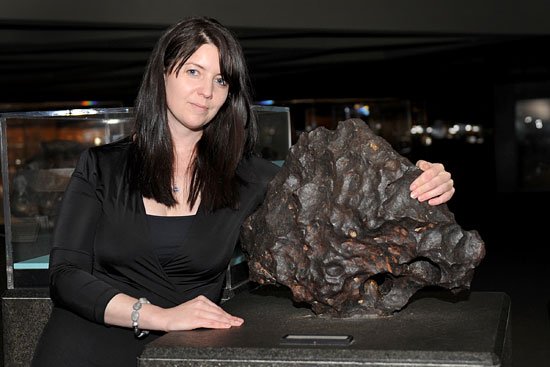
Alyssa Morgan with a chunk of the Canyon Diablo meteorite, which helped scientists determine the Earth
Posted 2/22/13
Coming down the track: Cell and Wi-Fi
February 21, 2013
It’s available at the corner coffee shop, the public library and LAX. But cell phone and wireless service on the L.A. subway? Sorry, wrong number.
After several years of study, though, that may be about to change.
A Metro committee this week approved awarding a contract to InSite Wireless to build the network and serve as the host for the various cell and data service providers whose customers will be using the service as they ride the rails or wait on station platforms.
If approved by Metro’s full board next week, it will take two years to build the underground network and get cell phone service up and running. Wi-Fi access, using the same antenna system installed for cell phones, is expected to follow.
“All the major cities are doing it—even London, which has a very old infrastructure. Paris has it on all its lines,” said project manager Daniel Lindstrom, Metro’s manager of wayside communications. In the U.S., he said, cities ranging from New York to Seattle have a system in place or in the planning phases.
“My own wife is saying, ‘When are you going to get that installed so I can get ahold of you?’ ”
A report to Metro’s Executive Management Committee said the agency stands to receive at least $360,000 annually from the new system—and its share of revenue from InSite could go much higher. The report said that Bay Area Rapid Transit in northern California reported $2 million a year in new revenue after installation of cell and data services.
Passengers won’t pay extra to use their phones on the subway, but their service providers would pay a fee to InSite, which would split a portion of that revenue with Metro.
After reviewing networks in place in San Francisco, Boston and Washington, D.C., Metro concluded that “the transit experience is significantly enhanced and overall personnel and business productivity has increased when patrons have cell phone and Wi-Fi access.”
What’s more, the report said, Amtrak experienced a 2% jump in ridership since the service was installed in its trains.
Cell phone service also is expected to make it easier for public safety officials to respond to emergencies, and to make passengers feel safer when they’re on the subway or waiting on the platform.
Posted 2/21/13
Getting their just rewards
February 14, 2013
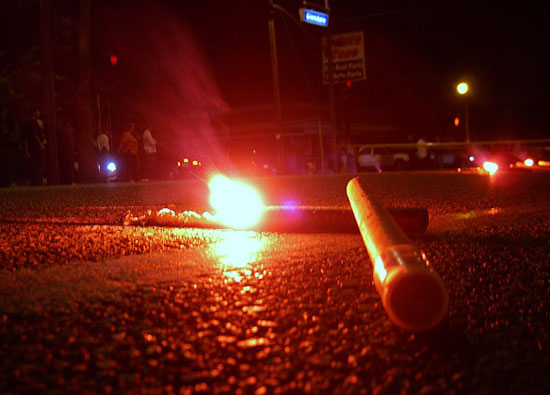
A county reward helped authorities find the Glendale driver in a fatal hit-and-run. Photo/Bryan Frank
Just hours before fugitive ex-cop Christopher Dorner was finally cornered in a hijacked cabin near Big Bear, the Los Angeles County Board of Supervisors had joined the manhunt: On Tuesday morning, it authorized a $100,000 reward for his capture, on top of the $1 million offered in private and public funds by the City of Los Angeles.
Now, with the quadruple murder suspect dead, it’s unclear exactly how—or if—the county’s bounty will be doled out to those who’ll inevitably step forward asserting that their information was crucial in Dorner’s discovery and demise. Ultimately, under county law, a recommendation will be made by representatives of the Chief Executive Office, Sheriff’s Department and Board of Supervisors, whose five members will have the final say.
The Dorner reward made news, of course, because of the international magnitude of the case, upstaging even President Obama’s State of the Union address as the drama came to a fiery conclusion Tuesday evening. But with less fanfare, the county for decades has been offering and paying rewards for information that has helped authorities obtain convictions for crimes ranging from multiple murders, to racially-inspired vandalism to animal cruelty.
During the past five years, the Board of Supervisors has authorized more than 140 reward offers—totaling $1.9 million—on behalf of law enforcement agencies throughout the county. Of those, the county has paid 25 claims worth about $225,000. The biggest payout came last April, when 10 people shared $30,000 for providing information that led to the arrest and conviction of assailants in the so-called “49th Street Massacre.” In that 2006 tragedy, three people, including a 10-year-old boy on a bike, were gunned down in a mistaken identity gang shooting in South Los Angeles.
Over the years, questions have been raised about how crimes are selected for rewards and whether the publicity surrounding a case—or the victim’s race—might unduly tip the scales. In the late 1990s, entertainer Bill Cosby asked that several taxpayer-funded reward offers be rescinded after his son, Ennis, was murdered while changing a tire on a darkened road near Bel Air. The family did not want to make it appear they were getting preferential treatment. Although the state and City of Los Angeles declined Cosby’s request, the Board of Supervisors withdrew its $12,500 reward.
For the most part, however, law enforcement officials dismiss such concerns and criticisms, saying they only seek rewards from the supervisors or other municipal bodies when investigations of particularly heinous crimes go cold and the public remains at risk.
“They are effective, absolutely,” Sheriff’s Department spokesman Steve Whitmore says, although he acknowledges that the offer of money can make investigations more complicated. “A lot of the tips aren’t fruitful,” he says. “But the important thing is that a lot of them are.”
Such was the case for frustrated Glendale Police Department detectives, whose investigation into the hit-and-run death of Elizabeth Sandoval in 2007 was at a standstill. The 24-year-old woman was thrown 100 feet after she was struck by a black Mercedes-Benz as she jaywalked across Glendale Avenue in the darkness of night.
“If the driver could just look into their heart and see that things would be better for him or her if they came forward,” Sandoval’s grief-stricken father pleaded after his daughter’s death. “Just do yourself a favor and turn yourself in,” her brother urged.
But it wasn’t until the Glendale City Council and the L.A. County Board of Supervisors each offered $10,000 in reward money that police got a breakthrough that led to the arrest and conviction of Ara Grigoryan, 23, who, according to the informant, had fled to Mexico.
Without the reward, says Glendale police spokesman Sgt. Tom Lorenz, “it would never have gotten solved.” The informant, he says, “made it very clear to us that she called because there was an offer of a reward…She kept calling back until she got the money.”
Long Beach police officials, meanwhile, credit a $25,000 county reward with helping them crack one their biggest cases in recent years—the 2006 murder of Los Angeles County Deputy Sheriff Maria Cecilia Rosa. She was shot twice just after dawn by robbers while loading bags into her car before heading from Long Beach to her assignment in the county jails. “It was a coldblooded killing,” Sheriff Baca told the media. “Who is truly safe? No one.”
A little more than a month after the reward offer, an informant gave Long Beach police the name of the suspected gunman and arranged a meeting between detectives and another individual who revealed where one suspect was believed to be living. In the end, two men—both of whom were already serving state prison time—were convicted in the deputy’s murder. One was sentenced to death; the other was given 29 years to life.
“The reward prompted an otherwise unwilling witness to come forward and provide information which allowed detectives to focus on a small group of suspects,” says Long Beach police spokesman Sgt. Aaron Eaton.
Long Beach police also benefitted from another reward offered by the county—this one involving the murder of popular honors student Melody Ross, 16, who was hit by gunfire that was sprayed into a group of young people leaving the 2009 Wilson High School homecoming football game. Two witnesses shared the $20,000 reward after giving authorities information that led to the arrest and conviction of two teenaged defendants.
Financial incentives, Easton says, “sometimes mean the difference between making an arrest or the case going unsolved.”
But not always.
The largest county reward anyone can remember—$150,000—was first offered in late 2002, after the death of 15-year-old Brenda Sierra, whose body was found off a mountainous road in San Bernardino County. She died from a blow to the head. The unusually high reward was approved by the board at the request of Supervisor Gloria Molina, whose district includes East Los Angeles, where the teenager lived and was last seen alive.
For nearly a decade, the reward was repeatedly renewed for six-month stretches in the hopes that someone would come forward and bring a measure of closure to the long grieving family. “Until we find her killer, we’re not giving up,” Molina said in announcing the award’s extension in July, 2009.
The reward finally expired in mid-2010, and the case remains unsolved.
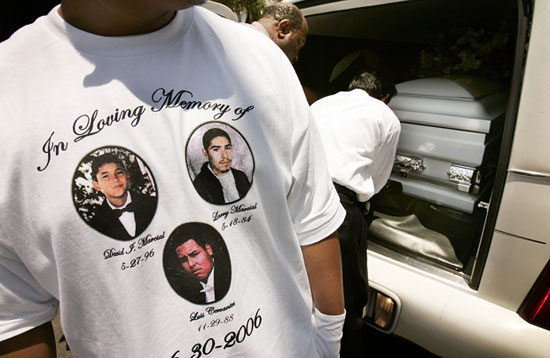
Police got a break in the "49th Street Massacre" case thanks to a $30,000 reward. Photo/Los Angeles Times
Posted 2/14/13
Smokers got you down? Light up a line.
February 14, 2013
So the neighbor is polluting your place with cigarette smoke. Who you gonna call?
For a growing number of Southern Californians, it’s the Los Angeles County Department of Public Health.
For years, the department’s Tobacco Control and Prevention Program has manned a phone line for complaints about those who flouted state laws against smoking, and for years, those calls mostly involved bars, restaurants and workplaces.
Lately, however, secondhand smoke wafting into apartments, condos and nursing home units has kept the line buzzing, says Tobacco Control deputy director Monty Messex. In the last six months alone, he says, 88 such complaints have come in via the Tobacco Control complaint line, far more than in past years. Forty-two percent, he added, came from the City of Los Angeles.
“It’s possible that people are smoking more in their apartments now because there are fewer and fewer places anymore to smoke in public,” Messex says, “but I think it’s more about awareness. People are realizing they have a choice.”
Smoke-free housing has become the latest frontier in the tobacco control movement, as health advocates and apartment dwellers have sought to stop secondhand smoke from drifting out of patios, balconies and neighboring units into non-smokers’ homes.
Despite arguments from some smokers and civil libertarians who view the push as an inconvenience and intrusion, California has led the charge in clearing smoke from shared living spaces. The state Department of Public Health has aired popular TV ads depicting secondhand smoke rising from vents to threaten small children, and more than two dozen jurisdictions including Santa Monica and Calabasas have adopted ordinances that restrict smoking in multi-unit housing. Last year a state law went into effect giving landlords permission to manage smoking in rental properties.
Next month, the Los Angeles County Housing Authority, which manages and owns 3,258 public and affordable housing units, is expected to seek approval on lease changes that would ban smoking within 20 feet of its buildings. Maria Badrakhan, director of the Housing Authority’s housing management division, says the move will affect some 7,000 renters from West Hollywood and Marina Del Rey to East Los Angeles and Long Beach, but so far, residents’ reactions have been overwhelmingly positive.
“We have a lot of seniors, a lot of families and people whose children have asthma, and we receive a lot of complaints from people who don’t want smoking in their buildings,” says Badrakhan, adding that the Department of Public Health has been working with the authority to help tenants quit smoking.
“We’re trying to create a better quality of life.”
The Tobacco Control complaint line—which essentially rings during business hours into the Tobacco Control and Prevention Office at 213-351-7890—is just a small part of the county’s effort to connect victims of secondhand smoke with agencies and authorities who can help.
The DPH’s Messex says it’s a challenging assignment, given the 88 separate jurisdictions and the patchwork of municipal smoking ordinances in the county. Sometimes, he says, the response is as simple as sending a letter to the property manager or owner and referring the caller to the appropriate fire department or code enforcement unit. Often, however, the county also will send callers to organizations such as S.A.F.E. (Smokefree Air For Everyone), a Granada Hills-based advocacy organization that operates an online, smokefree apartment registry.
“More and more people have come to us from the county,” says S.A.F.E.’s associate director, Marlene Gomez. “We’re getting 5 to 10 calls a week, and email in droves.”
Some of the complaints are heart-wrenching, says Gomez. “I had one case where a mother called from a rent control apartment in Wilmington with three kids—a 4-year-old, a 5-year-old and a 4-month-old baby—and the 5-year-old has asthma and smokers had moved in downstairs.”
In that case, she says, she was able to persuade the landlord to move the family to a different apartment and to let him know that he could keep smokers away in the future by specifying units as non-smoking as they became vacant.
But for many of those who complain, Messex says, recourse is limited because restrictions have yet to be enacted by the state or by most of the municipalities in the county, including the City of Los Angeles, and the bans that do exist vary from jurisdiction to jurisdiction.
“There’s not a lot we can do,” he says. “And in some cases, the situation is pretty severe.”
Apartment dwellers like Cris Borgnine say comprehensive restrictions would make a difference. Borgnine, a 46-year-old cameraman and photographer with two little boys at home, aged 3 and 7, says he started searching for help after smokers moved in not only next door, but also around the corner and downstairs from his North Hollywood apartment.
“It’s been really frustrating,” Borgnine says. “The smoke comes up through the kitchen fans and the heating ducts. When the onshore breeze blows, it comes in through our bedroom window. When you’re having dinner, it’s awful.”
In addition to his concern for his family’s health and the impact on his quality of life, Borgnine adds, his irritation had a personal angle: His father, the late actor Ernest Borgnine, had to have throat surgery at one point in his life because of complications from smoking. So when calls to the apartment manager failed to persuade his neighbors, he started dialing.
Eventually, he says, he got through to the county’s complaint line, only to learn that little could be done in his jurisdiction, other than sending his property manager a letter.
“We really need to do something about this,” he says. “Fortunately, my family and I have the resources to move to a new place, but the next person to move in is still going to have to deal with it.”
Posted 2/14/13
Look who’s in the fast lane
February 7, 2013
As Los Angeles learns the ins and outs of its first toll roads, the agency behind the pilot project is taking a look at who the early adopters are.
And wondering why folks in Tenafly, New Jersey, Peoria, Illinois and Peterborough, New Hampshire saw fit to purchase one of the new transponders to drive on the 11-mile stretch of ExpressLanes on the 110 Freeway south of downtown L.A.
“Maybe they’re business travelers. Maybe they’re the parents of students going to school out here,” said Stephanie Wiggins, who manages the ExpressLanes project for Metro and says she expects to learn more about the out-of-town phenomenon as research continues.
As it stands now, people from more than 400 cities and towns in California and across the country as far away as Honolulu have purchased FasTrak transponders since the program started in November.
Most, however, are from Los Angeles County—where Metro’s ZIP code analysis shows that Los Angeles residents are the top transponder buyers, followed by people in Torrance, Redondo Beach and Long Beach. The Top 10 also includes residents of more northerly communities like Pasadena and Glendale.
Some 88,000 transponders were in circulation as of Tuesday, putting the project on a fast track toward reaching its goal of 100,000 in its first year of operation.
A second set of toll lanes, running for 14 miles on the 10 Freeway between Alameda Street in downtown Los Angeles and the 605 Freeway, is set to open on Feb. 23.
As Metro and Caltrans prepare to roll out the lanes on the 10, they’re analyzing what they’ve learned so far and how to apply it.
For example, outreach is being stepped up to include 230 religious institutions along the 110 corridor, where brochures will be distributed and “pulpit presentations” are planned, either by clergy or ExpressLanes representatives.
“Faith-based organizations are a powerful forum for getting information out to community members,” Wiggins said.
They’re also a good place to get out the word about the program’s “equity plan,” in which low-income households can get a transponder for $15—instead of the $40 usually required. Smaller discounts for transponders, which work on toll lanes throughout California, not just in L.A. County, are available when purchased through the Automobile Club of Southern California, Costco and Albertsons.
There have been no accidents attributed to the ExpressLanes, but officials are increasing signage to make sure motorists know the rules of the road. Wiggins said there have been reports of “near-misses” on the 110 involving drivers who have dangerously crossed the double white lines between the toll lanes and regular lanes, perhaps trying to avoid a fine for getting caught on camera without a transponder.
Another side effect of the toll lanes: traffic has gotten more congested in the freeway lanes next to them. Wiggins said that traffic should eventually revert to normal as motorists become familiar with the stretch and the influx of CHP officers now patrolling it.
On another front, Metro’s Board of Directors is considering whether to scrap the program’s $3 monthly maintenance fee, which is charged to occasional users who drive in the lanes fewer than four times a month. Supervisor and Metro Director Zev Yaroslavsky contends in a motion that the fee should be dropped as a matter of fairness.
The ExpressLanes replaced what was formerly a high-occupancy vehicle lane on the 110. But Metro’s analysis shows that carpoolers—who ride for free in the new lanes as long as they purchase a transponder—still represent 62% of the customers so far and have been using the lanes most heavily between 7 a.m. and 8 a.m.
Solo drivers, who pay tolls when they use the lanes, make up 38% of ExpressLanes users and are out in greatest force between 8 a.m. and 9 a.m.
Overall, the number of daily trips is increasing, from 39,820 in mid-November to 43,900 by mid-January.
For those overseeing the pilot project, though, the most important number is 45—as in miles per hour. That’s the minimum average speed the lanes must achieve to be considered a success, under the terms of the $210 million federal grant that’s paying for them.
So far, they’ve been up to speed 100% of the time.
Posted 2/7/13
Beverly Hills cultivates some history
February 7, 2013
Virginia Robinson put Beverly Hills on the map as an enclave of the rich and famous. Now, more than a century later, Beverly Hills has returned the favor to its storied grand dame.
The Virginia Robinson Gardens, bequeathed to Los Angeles County after its namesake’s death in 1977, last month became an official local historic landmark. Built in 1911 by the Robinson’s department store heir Harry Winchester Robinson and his then-new bride, Virginia, the 6½-acre estate on Elden Way—now run under the auspices of the Los Angeles County Department of Parks and Recreation—has long held landmark status at the state and national level.
“This was essentially the first great estate in Beverly Hills,” explains Robinson Gardens Superintendent Timothy Lindsay.
But Beverly Hills created its historic designation only a year ago, prompted by the near-demolition of an architecturally significant house designed by Richard Neutra. The city has since named seven local landmarks, with more in the pipeline, according to Noah Furie, a former Beverly Hills planning commissioner and founding chairman of the city’s new Cultural Heritage Commission.
The Robinson estate was the second property in the city to receive the designation, after the neighboring Beverly Hills Hotel.
“This is one of the most unique properties in our city,” says Furie. “With all its different types of gardens, and its owners being the founders of one of Los Angeles’ most important department store chains, and their many contributions to the immediate and greater community, it checked off multiple criteria in our ordinance.”
Furie says the new local ordinance has proven to be a milestone for Beverly Hills. Even before the aborted demolition of Neutra’s Kronish House in 2011, preservationists had feared for the city’s architectural history.
“It was getting to the point that, if we didn’t do something, our past would be lost forever,” he says. “Significant estates done by master architects had been subdivided into multiple properties. We’d lost, including major remodels, the Burton Green estate, the Max Whittier estate, the Gershwin House—the list is a mile long.”
The new preservation ordinance imposes strict rules for changing or demolishing buildings that are older than 45 years and that either have some historic or cultural significance or are designed by master architects.
The Robinsons discovered their site in the early 1900s while searching for the Los Angeles Country Club in what was then the rural edge of the city. When they finished the house, designed for them as a wedding gift by Virginia’s father, architect Nathaniel Dryden, fields of barley stretched before them to the horizon.
But as the city grew up, the property, which was landscaped by Virginia and a dozen full-time gardeners into an expansive collection of lush, terraced gardens, became a public gathering place and an A-list destination. The Italianate pool house alone was 3,000 square feet and the palm grove still boasts the largest collection of Australian king palms in the continental United States.
Celebrities from Mary Pickford and Douglas Fairbanks to Fred Astaire and Ginger Rogers cavorted at the Robinsons’ lavish parties, as did a who’s who of Southern California society and business. Even after Harry Robinson died in 1932, Virginia—who took over the department store chain that her husband’s father had founded—maintained the civic momentum, accompanied by her beloved pets (she never had children and never remarried). For 33 years, her home was the site of a famed Hollywood Bowl kickoff gala; her last major domo came from the Vatican and spoke five languages, according to the estate superintendent Lindsay.
“Virginia Robinson worked with Dorothy Chandler to build the Music Center, she was great friends with Lillian Disney and the Duke and Duchess of Windsor,” Lindsay says.
And, he adds, Virginia adhered to a level of hospitality that would have impressed Downton Abbey.
“She had a large staff of 21 trained in the same level of etiquette as the White House,” says Lindsay. “After 6 p.m., the men all had to put on black tie and tails. Invitations were handwritten. There was always valet parking. When you arrived at the house, one man in white gloves would open the gate and another would open the door and announce your arrival, and she would meet you in the receiving line.
“Remember, Southern California was still pretty much a dusty cowboy town, in those days. But she set a standard for gracious living. She had a legendary elegance.”
Posted 2/7/13
Expo 2’s ahead of the curve
February 7, 2013
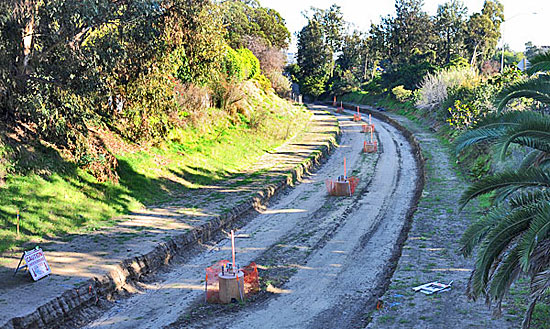
The Northvale Trench in Cheviot Hills, where Expo trains will run along a path blazed by their rail predecessors.
Maps and blueprints are fine, but there’s nothing like getting out into the real world and seeing the future take shape.
A few days ago, I had the opportunity to tour the second phase of the Expo Line, which is rapidly taking form along a corridor running from Culver City to Santa Monica.
It was remarkable. New bridges are rising, a once-abandoned railroad right-of-way is coming back to life and the contours of the project are emerging before our eyes.
The thrill of going behind the scenes in the construction zone was kind of like seeing a prenatal sonogram: Expo Phase 2 is still a long way from the delivery room, but this baby’s shaping up beautifully.
When the 6.6 mile stretch is finished in 2015—with a final station just a short walk from the Pacific Ocean—it will complete the light rail line that’s now carrying more than 23,000 passengers a day between downtown Los Angeles and Culver City. It will offer a true alternative to the heavily congested Santa Monica Freeway that it parallels for much of its route.
And it will mark another crowning achievement in what I consider the golden era of public transportation infrastructure development in the Los Angeles region.
Think about it: in just the last 10 to 15 years, we’ve built a subway to the San Fernando Valley, forged light rail connections to Pasadena, East Los Angeles and Culver City, and created two legs of the Orange Line rapid transit busway that now runs from North Hollywood to Chatsworth. Workers currently are constructing a new stretch of the Gold Line from Pasadena to Azusa, and work should be starting on the Crenshaw Line to LAX in the not-too-distant future. We’re also preparing to extend the subway to the Westwood V.A. and to build a Regional Connector downtown to help tie it all together.
As we’ve grown the system, the whole has proven to be much bigger than the sum of its parts, offering a bustling network of region-wide connections that would have been unthinkable a generation ago.
In our notoriously sprawling and supposedly car-dependent region, we’ve shown that Angelenos aren’t wedded to their automobiles and in fact are more than willing to vote with their feet if we can offer alternatives to an increasingly clogged freeway system.
I fully expect them to beat a path to the Expo Line when it’s complete. I’m not just talking about folks who live on the Westside but also the thousands throughout the region who commute there for jobs and recreation.
From what I saw during my tour, it’s clear that this line will offer them more than just a great escape from traffic on the 10. It also will provide a bargain tour of Los Angeles rarely glimpsed through the windshield of a car. It includes a sylvan stretch in Cheviot Hills where the Red Car once ran, panoramic views from bridges and elevated platforms along the route, and a middle-of-the-street trip through the pleasant urbanscape of Colorado Boulevard before it concludes at 4th Street and Colorado, just across from Santa Monica Place and down the street from the Pier.
Construction projects, of course, are highly unpredictable but I’m happy to report that this one, for now, is on time and on budget—maybe even a little ahead of the game.
But we can’t afford to let up.
Funding for Expo Phase 2 and other projects comes from Measure R, the ½-cent sales approved by 68% of county voters in 2008. Disappointingly, efforts to extend the sales tax for another 30 years—making it possible to get moving sooner on an array of transportation projects—failed at the ballot box this past November.
The extension, known as Measure J, lost even though it received 66.11% of the vote because of an anachronistic provision in our state constitution requiring two-thirds voter approval for such measures.
This needs to change.
So as construction teams work to finish Expo, efforts are building in Sacramento to try to move the approval threshold from two-thirds to a still-difficult but more reasonable 55%.
I hope that the state’s voters are ready for the change, and for the improvements in transportation infrastructure it could generate.
Because here in Los Angeles, we’re building a transit system that will benefit our region for generations. And we have no intention of turning this train around now.
Posted 2/7/13
Senses mingle in Grand Park
February 6, 2013
“I was just walking back into the Metro station when I heard the music and smelled the fried chicken,” explains Stefanie Hamlyn, a theatre teacher from The Webb Schools in Claremont.
And just like that, Grand Park made another new friend.
Hamlyn had just finished escorting students on a field trip to the Music Center when she stumbled across the first installment of “Lunchtime Concerts in Grand Park,” a series that pairs live musical performances with savory delights from L.A.’s famous gourmet food trucks.
The events will take place between noon and 1:30 p.m. on alternating Tuesdays through May. They’ll feature new tastes each time along with an eclectic mix of local music—including opera, jazz, Latin, rock and “singer-songwriter” styles. Along with the park’s popular lunchtime yoga series, the concerts are designed to attract workers from nearby buildings and catch the attention of passers-by like Hamlyn, says Julia Diamond, Grand Park’s programming director.
“We are really aiming to make midday in Grand Park a wonderful experience on a regular basis,” Diamond says.
Judging by Tuesday’s turnout, they’re off to a good start. Despite dreary skies and temperatures in the 50s, dozens of children ran around as an audience watched the 5-piece Colburn Brass ensemble and workers enjoyed lunch breaks in the park’s signature pink chairs. Lines for the food trucks stretched 30 long. It was an encouraging sign for Diamond, who notes that “Angelenos aren’t known for being the toughest when it comes to cold weather.”
Meanwhile, Hamlyn was happily absorbing her first experience in Grand Park, excited to see a slice of green downtown.
“It’s much better than it used to be,” she says, referring to the drab patchwork of concrete and grass that used to dominate the location.
As the weather warms and more people become aware of the park, Diamond says, she’ll be custom-tailoring events, including integrating dance performances into the mix. When summer hits, Diamond plans to create events using the remodeled Arthur J. Will Memorial Fountain and its new membrane pool, in which guests are encouraged to splash.
For Aaron Wilson, a 40-year-old musician from Silver Lake, Tuesday’s event was already a bit too busy for his schedule.
“I always wanted to try Ludo Truck but the line was too long,” says Wilson, referring to the mobile eatery owned by Ludo Lefebvre, star of cooking shows like Top Chef and The Taste. Luckily, there was another option—the Gourmet Genie, which offered Mediterranean fare.
While Hamlyn sat, waiting for her chicken to reach a crispy brown from the Ludo Truck, she considered other ways to enjoy the park.
“My husband and I come down for the symphony all the time,” she said. “We live next to the Gold Line but never took Metro because we were afraid to walk that short distance to the Disney Hall. Now, I’m thinking maybe we can.”
Posted 2/6/13
A blueprint for healthy living
February 5, 2013
On Tuesday, the Board of Supervisors adopted a new Healthy Design Ordinance that will change zoning and permitting requirements to promote walking, bicycling, community gardens, farmers’ markets and other elements of good health in future Los Angeles County developments.
Aimed at curbing the epidemic of obesity, diabetes and other diseases, the ordinance is the result of an expanding partnership between planning and public health officials to tilt this car-bound and fast-food-laden metropolis toward a more wholesome scale.
Among other things, the ordinance will require sidewalks in new developments to be shadier, wider and more walkable. It will also mandate bike parking in new projects and make it easier for communities to create community gardens and farmers’ markets, which will be required to accept CalFresh payments, formerly known as food stamps.
For more on the impact of the new rules, click here, and for the text of the ordinance, click here.
Posted 2/5/13




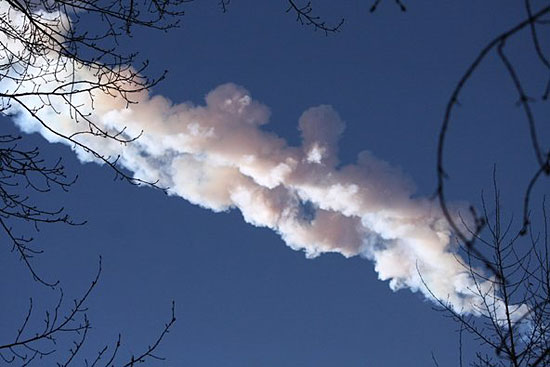
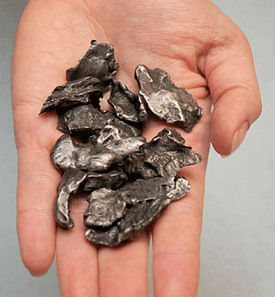
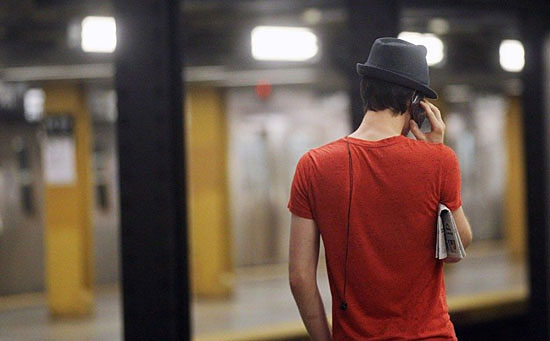
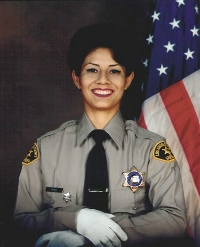
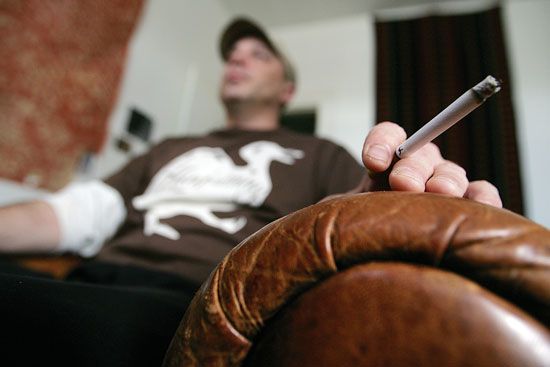
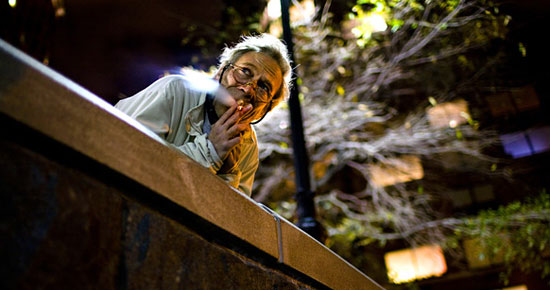
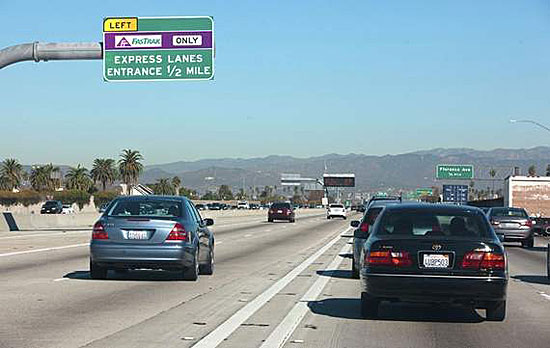
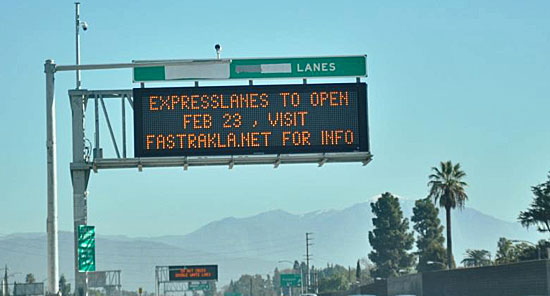
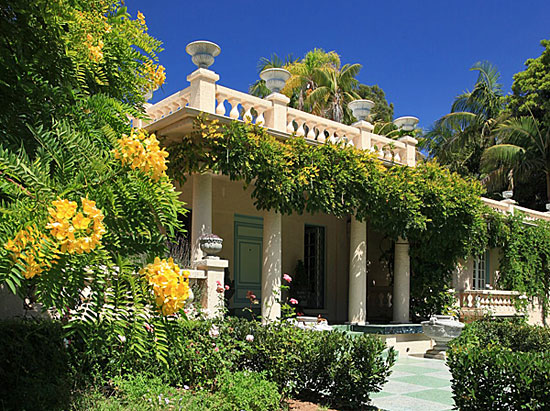
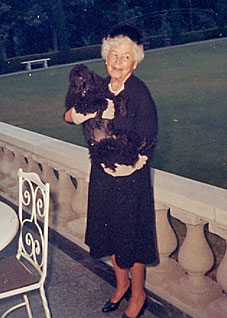

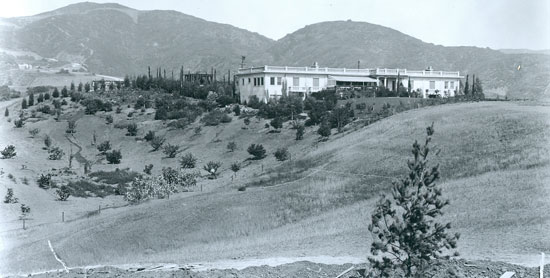
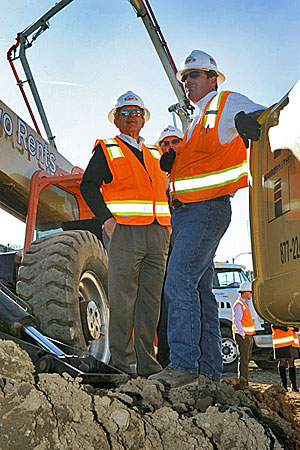
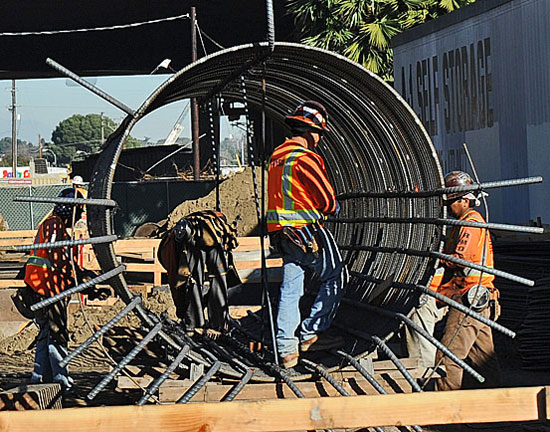
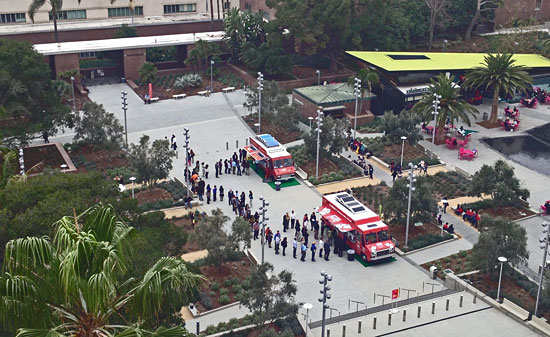
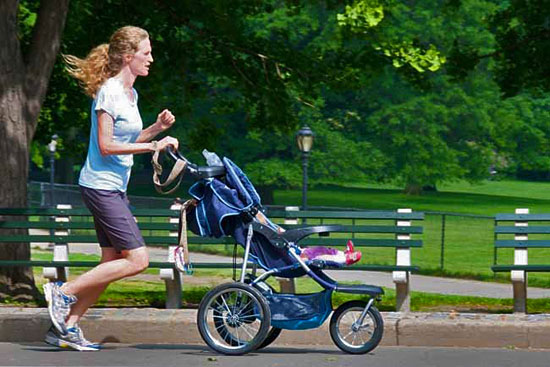





 Check for the latest closure information
Check for the latest closure information








